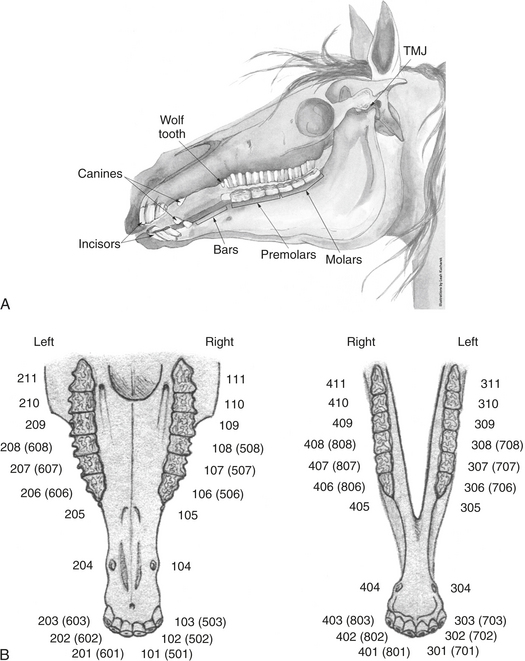CHAPTER 72 Iatrogenic Damage Caused by Modern Dentistry Procedures
Given the popularity of modern dental procedures, the veterinary practitioner must be aware of the potential damage that can be caused to horses’ teeth. The introduction of modern manual and powered cutting and rasping instruments has led to a substantial increase in the number of instances in which horses’ dentition is damaged.
NORMAL DENTAL ANATOMY
It is important to be familiar with normal dental anatomy so that abnormalities can be recognized and corrected without damaging the teeth. In addition, veterinarians should familiarize themselves with the Triadan tooth nomenclature (Figure 72-1). Equine teeth are hypsodont teeth, which have a short erupted crown and a long reserve crown and erupt continuously throughout a horse’s life. The normal structure of equine cheek teeth consists of an intricate pattern of hard enamel folds sandwiched between softer cementum and dentine. The difference in wear between the three materials results in a self-sharpening effect: the sharp enamel becomes exposed as coarse feed materials wear the softer cementum and dentine away. This also leads to raised areas on the occlusal surface in regions where there are an increased number of enamel folds. These lateral-to-medial raised areas, termed transverse ridges, are normal and function to increase the area of the occlusal surface.
Veterinarians should become familiar with the variations in the location and occlusal appearance of the pulp chambers and infundibuli of the maxillary cheek teeth. The maxillary cheek teeth have from five to eight pulp chambers, which can be recognized by the darkly stained secondary dentine. These teeth also have two infundibuli filled with light cream-colored cementum. The mandibular cheek teeth contain only five to seven pulp chambers and no infundibuli. In health, it should be impossible to insert a thin probe into the secondary dentine that seals the pulp chamber, but a probe can often be inserted into a small hole in the center of the cementum of the normal infundibulum. The incisors on a young horse have a single infundibulum (cup) containing cementum.




